Sometimes ideas arrive half-baked. The question then is if that idea will ever mature into a full-fledged great idea, or will it always remain half-baked? And more importantly, will you have the patience to let the idea ripen, or will you discard it too soon?
A couple of years ago, I had the idea to plant about one hundred drumstick Allium in a bed on the east side of my driveway. I loved the way that these burgundy red heads floated above other plants in early summer, adding little exclamation points to the garden. The problem was the "other plants" in that vision. The planting that first inspired me had used near-white daylilies under the alliums. But that always struck me like a one-hit wonder. "Give me a ticket for an allium. . ." It would look great for a short period of time, then all those daylilies would start to look a little ratty.
So my alliums floated away above the mulch. I added some liatris, which only added more vertical interest to a very vertical vision. What to do?
Thanks to Fran Sorin's excellent interview with Piet Oudolf on Gardening Gone wild, I began to explore Piet's great website. And there I found directions on how to finish baking my idea.
Piet is a huge proponent of ornamental grasses and uses them in his designs with breathtaking effect. One of his gardens has paired my infamous drumstick alliums with a low-growing, clumping ornamental grass. That's when the light bulb went off over my head, and I muttered, "Sporobolus!"
Next week I shall plant about a dozen Sporobolus heterolepis, or Prairie Dropseed, in that bed. Stay tuned for photos next summer of my alliums floating above a bed of grass!
And my next post will be on my favorite topic of patience.
Thursday, October 15, 2009
Sunday, October 11, 2009
I'm lichen this!
When I was taking the sunset photos on Friday evening, I noticed that the lichen growing on the trunk of the ginkgo tree looked intriguing.

Today, I was very glad that I had taken the photo then. After two frosts, snow flurries and a hard freeze, the ginkgo leaves today looked rather sad and the lichen was not as colorful as it had been Friday night.
Hard to believe that we've had our first "official" snowfall on October 10th! A cold fall on the heels of a cold summer does not leave me thinking warm thoughts about winter.

Today, I was very glad that I had taken the photo then. After two frosts, snow flurries and a hard freeze, the ginkgo leaves today looked rather sad and the lichen was not as colorful as it had been Friday night.
Hard to believe that we've had our first "official" snowfall on October 10th! A cold fall on the heels of a cold summer does not leave me thinking warm thoughts about winter.
Friday, October 9, 2009
Friday evening sunset
Today was a cold and rainy Fall day that felt more like early November than October. I put my jacket on at 6:30 in the morning to head to work and at 6:30 pm I still had not taken it off; I couldn't seem to shake the cold and damp.
I was wasting time on the computer when I looked outside and realized that the setting sun had dropped below the layer of clouds. I grabbed the camera and headed outside to capture the amazing light. Here's a good photo of the sun highlighting the little bluestem and Indian grass:
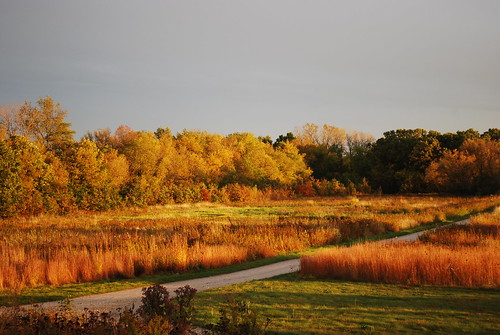
In this view, the sun is just catching the Red Wing Viburnum. This bed is on the east front corner of the house.
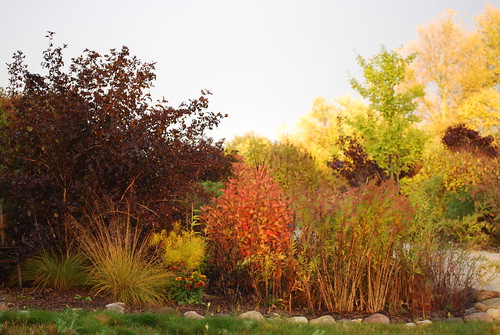
Here's the west front corner of the house. I wish I could photoshop out the antenna on top of the house, but I sure do appreciate the internet speed it provides.
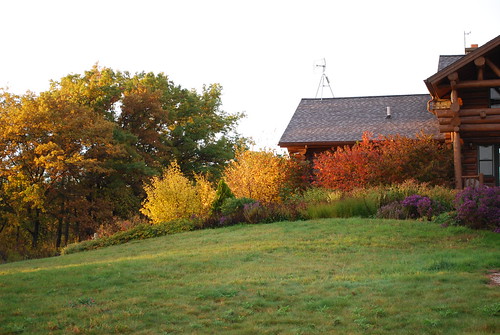
I was thinking the other day that I don't have a lot of fall color, but looking around tonight I think that perhaps I was too hasty in my judgment.
Finally, a view of the western sky with the clearing clouds.
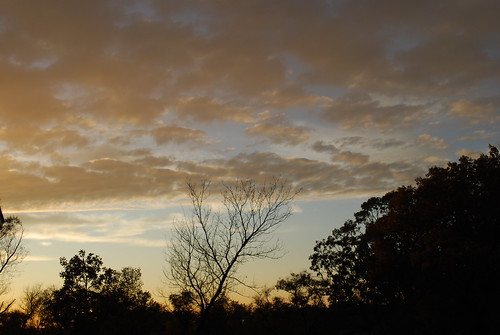
Those clearing skies contribute to the likelihood of a frost tonight. I think I'm ready to say farewell to the annuals.
I was wasting time on the computer when I looked outside and realized that the setting sun had dropped below the layer of clouds. I grabbed the camera and headed outside to capture the amazing light. Here's a good photo of the sun highlighting the little bluestem and Indian grass:

In this view, the sun is just catching the Red Wing Viburnum. This bed is on the east front corner of the house.

Here's the west front corner of the house. I wish I could photoshop out the antenna on top of the house, but I sure do appreciate the internet speed it provides.

I was thinking the other day that I don't have a lot of fall color, but looking around tonight I think that perhaps I was too hasty in my judgment.
Finally, a view of the western sky with the clearing clouds.

Those clearing skies contribute to the likelihood of a frost tonight. I think I'm ready to say farewell to the annuals.
Thursday, October 8, 2009
Some Fall Color
I took a quick walk around the garden yesterday afternoon to capture some of the fall highlights. We tend not to have a "blaze of glory" in the autumn; instead we find gleaming jewels here and there in the landscape.
About four years ago I was intrigued by a little viburnum in a quart pot at Vareigated Foliage Nursery in Connecticut. I brought it home in my suitcase, only to find out later that it's a Chicagoland Grows introduction. The Viburnum is V. trilobum Redwing, and it is supposed to be a true V. trilobum, which is the native American Cranberry bush. The spring foliage emerges with a red blush on the leaves, and in fall it really glows.

If you're not familiar with Chicagoland Grows, this is a plant introduction program that is a partnership among the Chicago Botanic Gardens, The Morton Arboretum and the Ornamental Growers Association of Northern Illinois. The goal of the program is to introduce plants that are well-adapted to Midwest growing conditions. More information on the program and the plants can be found at www.chicagolandgrows.org. (Sorry, but Blogger is not letting me make that a clickable link right now.) Disclosure: I am on the board of the Ornamental Growers Association of Northern Illinois.
I also love the foliage of the Oakleaf Hydrangea. My plant didn't bloom this year due to a late cold snap, but it grew quite well and is starting to get some nice fall color.
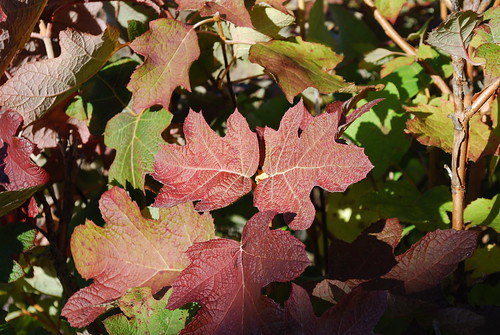
Enjoy the fall!
About four years ago I was intrigued by a little viburnum in a quart pot at Vareigated Foliage Nursery in Connecticut. I brought it home in my suitcase, only to find out later that it's a Chicagoland Grows introduction. The Viburnum is V. trilobum Redwing, and it is supposed to be a true V. trilobum, which is the native American Cranberry bush. The spring foliage emerges with a red blush on the leaves, and in fall it really glows.

If you're not familiar with Chicagoland Grows, this is a plant introduction program that is a partnership among the Chicago Botanic Gardens, The Morton Arboretum and the Ornamental Growers Association of Northern Illinois. The goal of the program is to introduce plants that are well-adapted to Midwest growing conditions. More information on the program and the plants can be found at www.chicagolandgrows.org. (Sorry, but Blogger is not letting me make that a clickable link right now.) Disclosure: I am on the board of the Ornamental Growers Association of Northern Illinois.
I also love the foliage of the Oakleaf Hydrangea. My plant didn't bloom this year due to a late cold snap, but it grew quite well and is starting to get some nice fall color.

Enjoy the fall!
Monday, October 5, 2009
My Abundant Harvest

Silphium integrifolium - Rosinweed
When I first saw that the theme for the Picture This Photo Contest on Gardening Gone Wild was Abundant Harvest I was disappointed. Our unusual summer weather has left us with a harvest that is far from stellar and a vegetable garden that has not one speck of beauty left in it. Tomato vines grew too slow, then too fast and then gave it up to fungus in our cool wet, September. Green peppers just didn't grow. Ever. I have a pepper plant that was transplanted into the garden in early June that is the exact same size today as it was back in June.
But then I realized that the harvest I most appreciate is the harvest of prairie seeds that we gather every fall. As we work to restore native prairie plants on our land, our annual fall task is to collect as many seeds as possible from the various natives. After the seeds are cleaned, we combine them for different planting conditions and spread the seed in other areas - hopefully, just before a December snowfall.
This rosinweed really caught my eye yesterday. The seed heads aren't quite ready for harvest, but I'll be keeping a close eye on this one over the next week or two.
Sunday, October 4, 2009
Harvest time!
No, I'm not bringing in the corn or beans. I'm harvesting seed from the native plants in the garden areas around the house. Later this fall, we'll spread this seed in areas where we're re-establishing native plants.
Today's harvest included thimbleweed, cup plant, nodding onion, Culver's root, liatris, baptisia and lead plant. Here's a photo from July 1st of the lead plant in full bloom:

I've read in a few places that lead plant can be hard to start from seed, but several years ago we spread seed in the prairie area on the west side of our property and now we have lots of lead plant coming up over there. I'll sow some of this year's seed in areas that are a little drier and more gravelly.
I'll continue to work on collecting seed over the next several weeds. Assuming that the goldfinches don't attack me first, since they were not happy that I took the liatris seed that they've been feasting on.
Today's harvest included thimbleweed, cup plant, nodding onion, Culver's root, liatris, baptisia and lead plant. Here's a photo from July 1st of the lead plant in full bloom:

I've read in a few places that lead plant can be hard to start from seed, but several years ago we spread seed in the prairie area on the west side of our property and now we have lots of lead plant coming up over there. I'll sow some of this year's seed in areas that are a little drier and more gravelly.
I'll continue to work on collecting seed over the next several weeds. Assuming that the goldfinches don't attack me first, since they were not happy that I took the liatris seed that they've been feasting on.
Subscribe to:
Posts (Atom)